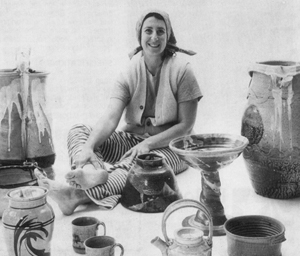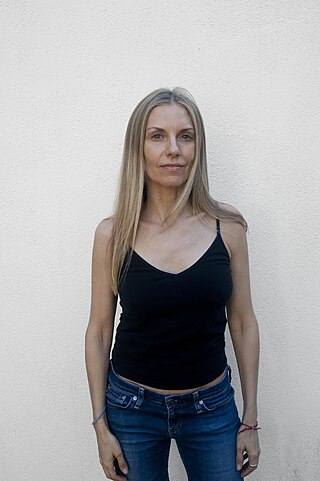Related Research Articles

Shirazeh Houshiary is an Iranian-born English sculptor, installation artist, and painter. She lives and works in London.

Elizabeth Woodman was an American ceramic artist.

Annie Pootoogook was a Canadian Inuk artist known for her pen and coloured pencil drawings. In her art, Pootoogook often portrayed the experiences of those in her community of Kinngait, in northern Canada, and memories and events from her own life.

Melanie A. Yazzie is a Navajo sculptor, painter, printmaker, and professor. She teaches at the University of Colorado at Boulder.

Jennifer Steinkamp is an American installation artist who works with video and new media in order to explore ideas about architectural space, motion, and perception.
Mr. is a Japanese contemporary artist, based in Saitama Prefecture, Japan. A former protégé of Takashi Murakami, Mr.'s work debuted in both solo and group exhibitions in 1996, and has since been seen in museum and gallery exhibitions in Tokyo, Osaka, Nagoya, Hong Kong, Seoul, Daegu, Paris, New York, Minneapolis, Chicago, Miami, Jerusalem, Los Angeles, and London.
Suling Wang is an internationally recognized painter and contemporary artist, known predominantly for her large scale abstract works. She currently lives and works in London, UK and Taichung, Taiwan.
Adriana Varejão is a Brazilian artist. She works in various disciplines including painting, drawing, sculpture, installation and photography. She was an artist-in-resident at the Isabella Stewart Gardner Museum in 2004. Varejão lives and works in Rio de Janeiro.

Liza Lou is an American visual artist. She is best known for producing large scale sculpture using glass beads. Lou ran a studio in Durban, South Africa from 2005 to 2014. She currently has a nomadic practice, working mostly outdoors in the Mojave Desert in southern California. Lou's work is grounded in domestic craft and intersects with the larger social economy.
The Museo Alameda was the largest Latino museum in the United States and the first formal Smithsonian affiliate outside of Washington D.C., located in the historic Market Square in Downtown San Antonio, Texas.
Angel Otero was born 1981. He is a contemporary visual artist specializing in painting.
Helen Pashgian is an American visual artist who lives and works in Pasadena, California. She is a primary member of the Light and Space art movement of the 1960s, but her role has been historically under-recognized.
Adriana Farmiga is an American visual artist, curator, and professor based in New York City. She serves as a programming advisor for the non-profit La Mama Gallery in the East Village, and is the current Associate Dean at Cooper Union School of Art. In June of 2024 Farmiga was promoted Dean at Cooper Union.

Jeon Joonho is a South Korean artist.
Yumi Janairo Roth is a Colorado-based visual artist who is known for her sculptures and site-responsive projects that explore themes of hybridity, immigration, and displacement. Working in diverse media, Roth's practice elevates the mundane, honors international craft techniques, and empowers the interloper to navigate unfamiliar places. Roth is an associate professor of Sculpture and Post-Studio Practice at the University of Colorado Boulder.
Vincent Valdez is an American artist born in San Antonio, Texas, who focuses on painting, drawing, and printmaking. His artwork often emphasizes themes of social justice, memory, and ignored or under-examined historical narratives. Valdez completed his B.F.A. at the Rhode Island School of Design in 2000. He lives and works in Houston, Texas, and is represented by the David Shelton Gallery (Houston) and Matthew Brown Gallery. Valdez's work has been exhibited at Museum of Fine Arts, Houston, Ford Foundation, Los Angeles County Museum of Art, National Portrait Gallery, Blanton Museum of Art, Parsons School of Design, and the Fundacion Osde Buenos Aires.

Sara Radstone is a British ceramic artist and lecturer. Her work ranges from intimate wall based sculpture to large scale installations of multiple elements.

Nyeema Morgan is an American interdisciplinary and conceptual artist. Working in drawing, sculpture and print media, her works focus on how meaning is constructed and communicated given complex socio-political systems. Born in Philadelphia, she earned her BFA from the Cooper Union School of Art and her MFA from the California College of the Arts. She has held artist residencies at the Skowhegan School of Painting and Sculpture and Smack Mellon. Morgan's works are in the permanent collections of the Bowdoin College Museum of Art and the Menil Collection.
Tina Havelock Stevens is an Australian multi disciplinary artist known for her drumming, documentaries, and video works. She often combines improvised live music performances with striking locations that explore the spirituality of place.
Esteban Ramón Pérez is an American artist who produces multi-media paintings and sculptures. His sociopolitical artwork often emphasizes subjective memory, spirituality, and fragmented history. Pérez earned a BFA from the California Institute of the Arts in 2017 and an MFA in painting and printmaking from the Yale School of Art, New Haven, Connecticut, in 2019. Pérez's work has been exhibited in numerous group exhibitions, including shows at Artspace, New Haven, Connecticut; Eastern Connecticut State University Art Gallery, Windham, Connecticut; Transmitter Gallery, Brooklyn; James Cohan Gallery, New York; Gamma Galería, Guadalajara, Mexico; Calderón, New York; the Arlington Arts Center, Virginia; Charles Moffett, New York; and Lehmann Maupin, New York. Solo exhibitions include Staniar Gallery, Lexington, Virginia. Pérez was selected for the NXTHVN Fellowship Program and is a 2022 recipient of the Artadia Award. He lives and works in Los Angeles, California.
References
- 1 2 "U.S. Latinx Arts Futures Symposium - Adriana Corral - YouTube". www.youtube.com. Retrieved January 6, 2021.
- 1 2 Films, Walley (September 25, 2018), 4x4: Adriana Corral - Why Are You an Artist? , retrieved January 6, 2021
- ↑ Films, Walley (January 9, 2019), 4×4: Adriana Corral – Who has influenced your work? , retrieved January 6, 2021
- ↑ "UTA -- Exhibitions at The Gallery". www.uta.edu. Retrieved January 6, 2021.
- ↑ "Adriana Corral". Joan Mitchell Foundation. February 15, 2017. Retrieved January 6, 2021.
- ↑ "Adriana Corral". Artadia. January 8, 2020. Retrieved January 6, 2021.
- ↑ "Adriana Corral". Black Cube. Retrieved January 6, 2021.
- ↑ "Unearthed: Desenterrado". Black Cube. Retrieved January 6, 2021.
- ↑ "ADRIANA CORRAL: LINE AS HUMAN / LA LINEA COMO CONCEPTO HUMANO". Glasstire. Retrieved January 6, 2021.
- 1 2 Ostrom, Reid; Ricks, James; Salchert, David; Lepage, Andrea (June 25, 2019). "Leaving a Trace". The Columns. Retrieved January 6, 2021.
- 1 2 "Adriana Corral: Unearthed/Desenterrado – Fall – Exhibitions". BMoCA – Boulder Museum of Contemporary Art. Retrieved January 6, 2021.
- ↑ "Xican-a.o.x. Body • Pérez Art Museum Miami". Pérez Art Museum Miami. Retrieved September 18, 2024.
- ↑ Vargas-Santiago, Luis; Dulitzky, Ariel (2015). Counter-Archives to the Narco-City. Copilot Press. ISBN 978-0982144848.
- ↑ Corral, Adriana (2019). "Artist's Statement" in Adriana Corral's Unearthed: Desenterrado. Lexington, VA: Staniar Gallery. p. 5. ISBN 978-0-578-45813-7.
- ↑ Boyd, Kealey (March 5, 2018). "Commemorating US-Mexico Collaboration on a Farm Where Guest Workers Toiled". Hyperallergic. Retrieved January 6, 2021.
- ↑ Stell, Cortney Lane (2019). "Adriana Corral's Unearthed: Desenterrado A Site Specific Artwork at the United States-Mexico Border," in Adriana Corral's Unearthed: Desenterrado. Lexington, VA: Staniar Gallery. p. 40. ISBN 978-0-578-45813-7.
- ↑ Markonish, Denise. "Suffering from Realness Gallery Guide" (PDF). Archived (PDF) from the original on October 25, 2020.
- ↑ Markonish, Denise (2019). Suffering from Realness. Prestel. pp. 110–111. ISBN 978-3791358192.
- ↑ "A Wake-Up Call at MASS MoCA: Suffering from Realness". The Greylock Glass. May 6, 2019. Retrieved January 6, 2021.
- ↑ "Eyes of the Skin - Curated by artist Teresita Fernández - Exhibitions - Lehmann Maupin". www.lehmannmaupin.com. Retrieved October 10, 2022.
- ↑ Diehl, Travis; Smith, Roberta; Farago, Jason; Heinrich, Will (October 5, 2022). "What to See in N.Y.C. Galleries Right Now". The New York Times. ISSN 0362-4331 . Retrieved October 10, 2022.
- ↑ "Adriana Corral - - Art - Lehmann Maupin". www.lehmannmaupin.com. Retrieved October 10, 2022.